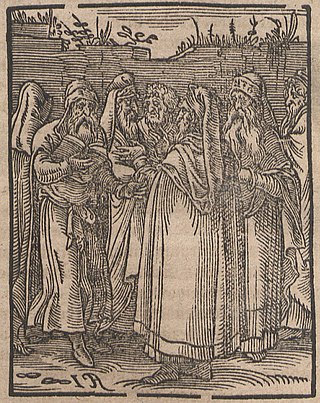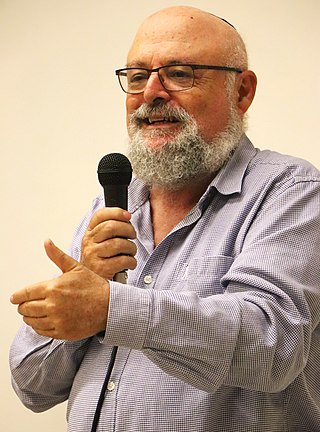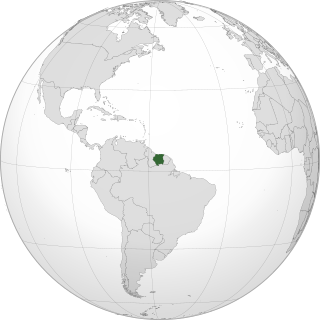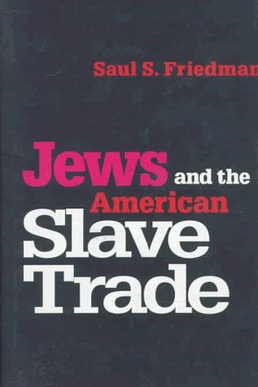Related Research Articles

Kabbalah or Qabalah is an esoteric method, discipline and school of thought in Jewish mysticism. A traditional Kabbalist is called a Mekubbal. The definition of Kabbalah varies according to the tradition and aims of those following it, from its origin in medieval Judaism to its later adaptations in Western esotericism. Jewish Kabbalah is a set of esoteric teachings meant to explain the relationship between the unchanging, eternal God—the mysterious Ein Sof —and the mortal, finite universe. It forms the foundation of mystical religious interpretations within Judaism.

A shofar is an ancient musical horn typically made of a ram's horn, used for Jewish religious purposes. Like the modern bugle, the shofar lacks pitch-altering devices, with all pitch control done by varying the player's embouchure. The shofar is blown in synagogue services on Rosh Hashanah and at the end of Yom Kippur; it is also blown every weekday morning in the month of Elul running up to Rosh Hashanah. Shofars come in a variety of sizes and shapes, depending on the choice of animal and level of finish.

Jacob's Ladder is a ladder leading to heaven that was featured in a dream the biblical Patriarch Jacob had during his flight from his brother Esau in the Book of Genesis.
African-American Jews are people who are both African American and Jewish. African-American Jews may be either Jewish from birth or converts to Judaism. Many African-American Jews are of mixed heritage, having both non-Jewish African-American and non-Black Jewish ancestors. Many African-American Jews identify as Jews of color, but some do not. Black Jews from Africa, such as the Beta Israel from Ethiopia, may or may not identify as African-American Jews.

Israel Knohl is an Israeli Bible scholar and historian. He is the Yehezkel Kaufmann Professor of Biblical studies at the Hebrew University of Jerusalem and a Senior Fellow at Shalom Hartman Institute in Jerusalem. His books deal with the integration of scientific and archaeological discoveries with the biblical account, early Israelite beliefs, a survey of Israelite cult, and how and where the Israelites originated.
Lurianic Kabbalah is a school of Kabbalah named after Isaac Luria (1534–1572), the Jewish rabbi who developed it. Lurianic Kabbalah gave a seminal new account of Kabbalistic thought that its followers synthesised with, and read into, the earlier Kabbalah of the Zohar that had disseminated in Medieval circles.

Messianism in Chabad refers to the contested beliefs among some members of the Chabad-Lubavitch community—a group within Hasidic Judaism—regarding the Jewish messiah. Very few members of the Chabad community believe that Rabbi Menachem Mendel Schneerson, the deceased seventh Rebbe of the Chabad-Lubavitch dynasty, is still alive but most believe that he is the Messiah. The issue remains controversial within both the Chabad movement and the broader Jewish community.

Jewish views on slavery are varied both religiously and historically. Judaism's ancient and medieval religious texts contain numerous laws governing the ownership and treatment of slaves. Texts that contain such regulations include the Hebrew Bible, the Talmud, the 12th-century Mishneh Torah by rabbi Maimonides, and the 16th-century Shulchan Aruch by rabbi Yosef Karo.

Jewish copper plates of Cochin, also known as Cochin plates of Bhaskara Ravi-varman, is a royal charter issued by the Chera Perumal king of Kerala, south India to Joseph Rabban, a Jewish merchant magnate of Kodungallur. The charter shows the status and importance of the Jewish colony in Kodungallur (Cranganore) near Cochin on the Malabar Coast.
Kabbalah, the central system in Jewish mysticism, uses anthropomorphic mythic symbols to metaphorically describe manifestations of God in Judaism. Based on the verses "God created man in his own image, in the image of God created he him; male and female created he them" and "from my flesh shall I see God", Kabbalah uses the form of the human body to describe the structure of the human soul, and the nature of supernal Divine emanations. A particular concern of Kabbalah is sexual unity between male and female potencies in Divinity on high, depicted as interaction of the two sides in the sephirot, between archetypal partzufim, and the redemption of the exiled Shekhinah from captivity among the impure forces below.

The history of the Jews in Suriname starts in 1639, as the English government allowed Spanish and Portuguese Jews from the Netherlands, Portugal and Italy to settle the region, coming to the old capital Torarica.

Jews and the American Slave Trade is a 1998 book by American historian Saul S. Friedman published by the Transaction Publishers. It focuses on the Jewish involvement in the American slave trade and is a polemical rebuttal against the 1991 work The Secret Relationship Between Blacks and Jews. It has also been described as contributing to the contemporary debates related to African American–Jewish relations.
Black Jews in New York City comprise one of the largest communities of Black Jews in the United States. Black Jews have lived in New York City since colonial times, with organized Black-Jewish and Black Hebrew Israelite communities emerging during the early 20th century. Black Jewish and Black Hebrew Israelite communities have historically been centered in Harlem, Brooklyn, The Bronx, and Queens. The Commandment Keepers movement originated in Harlem, while the Black Orthodox Jewish community is centered in Brooklyn. New York City is home to four historically Black synagogues with roots in the Black Hebrew Israelite community. A small Beta Israel (Ethiopian-Jewish) community also exists in New York City, many of whom emigrated from Israel. Black Hebrew Israelites are not considered Jewish by the New York Board of Rabbis, an organization representing mainstream Rabbinic Judaism. However, some Black Hebrew Israelite individuals in New York City are recognized as Jewish due to converting through the Orthodox, Conservative, or other Jewish movements.
Racism in Jewish communities is a source of concern for people of color, particularly for Jews of color. Black Jews, Indigenous Jews, and other Jews of color report that they experience racism from white Jews in many countries, including the United States, Canada, the United Kingdom, France, Kenya, South Africa, and New Zealand. Sephardi and Mizrahi Jews also report experiences with racism by Ashkenazi Jews. The centering of Ashkenazi Jews is sometimes known as Ashkenormativity. In historically white-dominated countries with a legacy of anti-Black racism, such as the United States and South Africa, racism within the Jewish community often manifests itself as anti-Blackness. In Israel, racism among Israeli Jews often manifests itself as discrimination and prejudice against Sephardi and Mizrahi Jews, Ethiopian Jews, African immigrants, and Palestinians. Controversially, some critics describe Zionism as racist or settler colonial in nature.
Lucy Marks was an African-American Jew from Philadelphia, one of the few documented Black Jews during early American history. An active member of Congregation Mikveh Israel, she is buried in Mikveh Israel Cemetery.
Tomás Treviño de Sobremonte was a Crypto-Jewish martyr. Born in Spain, Treviño fled to New Spain at around age 20. There he practiced Judaism secretly until his discovery and execution. His defiance and refusal to accept Catholicism has made him an important figure in studies of early Jews in Latin America, and he is regarded as one of the best-known victims of the Spanish Inquisition.
Julie Winch is a history professor and author in the United States. She was born in London. She wrote a book about Philadelphia's black elite and edited, introduced, and footnoted Joseph Wilson's account of the city's elite before the Civil War. She also wrote a book about James Forten and the prominent family of Jacques Clamorgan in St. Louis and the Clamorgan family.

Sarah Brandon Rodrigues Moses was an African-American Jew, one of the earliest recorded Jewish women of African descent in American history. Born in Barbados, she and her brother Isaac Lopez Brandon went on to become part of the Sephardic upper class in New York City. Portraits of her and her brother Isaac are the earliest known paintings of Jews of African descent in North American history.
Isaac Lopez Brandon was an African-American Jew, one of the earliest recorded Jews of African descent in American history. Born in Barbados, he and his sister Sarah Brandon Moses went on to become part of the Sephardic upper class in New York City. Portraits of him and his sister are the earliest known paintings of Jews of African descent in North American history. In Barbados, Brandon fought for the equal civil rights of the Jewish minority.
Darhe Jesarim was a Black Jewish synagogue formed in Suriname. It is the earliest known synagogue in the African diaspora. The synagogue was later disbanded and Black and mixed-race Jews were integrated back into Suriname's predominantly white synagogues as second-class members.
References
- ↑ Review of Once We Were Slaves
- Casteel, Sarah Phillips (2023). "Review of Once We Were Slaves: The Extraordinary Journey of a Multiracial Jewish Family". NWIG: New West Indian Guide / Nieuwe West-Indische Gids. 97 (3/4): 426–427. ISSN 1382-2373.
- ↑ Review of The Art of the Jewish Family
- Abrams, Jeanne (2020). "Review of The Art of the Jewish Family: A History of Women in Early New York in Five Objects". Jewish Historical Studies. 52: 295–296. ISSN 0962-9696.
- ↑ Review of Messianism, Secrecy and Mysticism
- Snyder, Holly (2014). "Review of Messianism, Secrecy and Mysticism: A New Interpretation of Early American Jewish Life". Shofar. 32 (2): 146–148. doi:10.5703/shofar.32.2.146. ISSN 0882-8539.
- Lee, Lloyd; Richardson, Robbie (2010). Leibman, Laura Arnold (ed.). "Review". American Indian Quarterly. 34 (1): 118–120. doi:10.5250/amerindiquar.34.1.118. ISSN 0095-182X.
- Pencak, William A. (2013). "Review of Messianism, Secrecy, Mysticism: A New Interpretation of Early American Jewish Life". American Jewish History. 97 (3): 329–331. ISSN 0164-0178.
- ↑ "Laura Arnold Leibman - Reed College". www.reed.edu. Retrieved 2024-05-12.